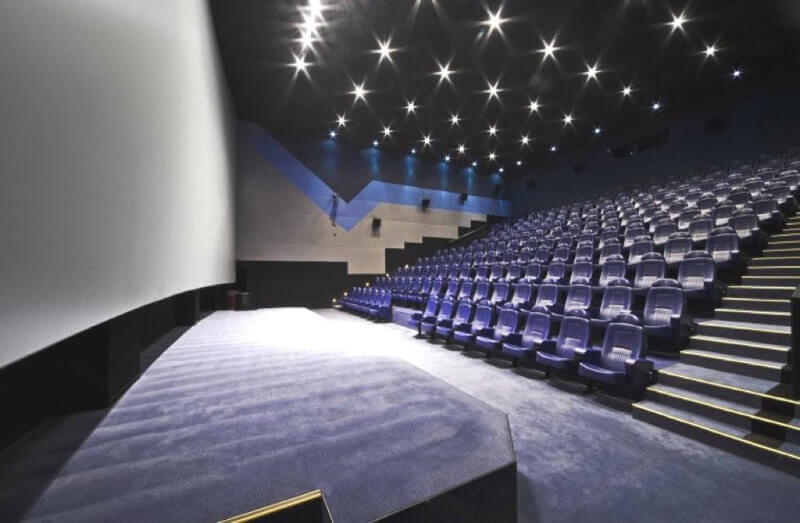Acoustic wall qualities and criteria for professional cinemas

The term ‘acoustics’ is defined as: ‘the properties or qualities of a room or building that determine how sound is transmitted in it.’ And getting the acoustics right is vital for good audience experience in the cinema.
Multi-screen cinemas have two main issues to contend with: sound travelling in and out of each auditorium, and reverberation, which affects sound quality.
Reverberation is caused by sound bouncing from wall to wall, and floor to ceiling, and it has a negative impact on the quality of sound. Highly reflective surfaces, which could include doors and fire exits in some venues, will cause problems too. The latter can be addressed with curtains.
Acoustic wall treatments are designed to resolve these issues, and are specifically tailored to each space to allow for individual characteristics such as size, shape, and design themes. They can also be used to good effect in the refurbishment of old cinemas. Please see KB2 – Refurbishing older cinemas with new acoustic walls
What is acoustic wall treatment?
Just to add a level of confusion, there is more than one name for this type of treatment. It is also known as:
- Acoustic soft wall treatment
- Acoustic panelling
- Acoustic wall systems
- Acoustic stretch wall
- Acoustic panels
- Acoustic cloth wall
We’ll refer it as acoustic wall treatment throughout this article.
What’s the difference between soundproofing and acoustic treatment?
While soundproofing reduces the amount of sound that gets into or out of a room, it doesn’t affect how sound travels around the space and therefore isn’t enough on its own to create pure sound.
Acoustic wall treatments offer much more than soundproofing.
Why acoustic treatments are necessary
Acoustic treatments address the sound quality of a room. So a film’s soundtrack will be much more accurate in a professionally treated auditorium than in one that’s untreated.
Everything in a space, from the walls, windows and doors, to the floors and ceilings, has an effect on how sound behaves. And of course the size and shape of a room plays a huge part too.
With analogue, acoustic treatments were used mainly to deaden sound and to stop it travelling around. However digitisation has increased the need to control reverberation to a very high standard.
What it is and how it works
Acoustic wall treatment absorbs high levels of reflective noise within a space.
The system consists of a plastic frame, in-filled with sheets of foam and covered with stretch fabric.
The design is marked out directly on to the walls. The plastic is cut to the design and each individual piece is fitted to wall to create panels or a continuous stretch. These are then infilled with foam. The final step is to cover the foam with cloth, fitting it into the frames.
Camtek is our own product and it forms the core of Camstage acoustic panels. It is a flexible, lightweight melamine-based acoustic foam. It provides a high sound absorbency, and has a Class 0 fire specification.
The foam sheets have a standard depth of 32mm, which can be increased to 50mm. The extra depth panels are usually installed on the back wall of a cinema to cut down the sound from the projection room.
Because cinema auditoriums come in all shapes and sizes, and not all walls are uniform - particularly in older buildings, the panels are built on site. Any stretch fabric can be used so there is a very wide range of colour and design from which to choose. This makes the panels extremely flexible as they can be tailored to individual specifications and design themes.
Lamaphon
In cinemas, another sound absorbent - Lamaphon – can be used in conjunction with, or without acoustic wall treatment.
Fitted to the rear of the projection screen wall, it stops sound bouncing behind the back of the stage wall and screen surface. This pushes a crisper sound forward into the auditorium, improving the sound quality for the audience.
Pleating
Pleating is another way to improve acoustics in a room.
Timber frames are fixed to the walls and fabric is stapled on the top and bottom timbers. The pleating is done in situ and the acoustic treatment is placed behind. Either Camtex foam, rockwool or Lamaphon slabs can be used behind the pleating.
Both acoustic wall treatments and pleating can also be used for aesthetic purposes, and they are very cost-effective ways to cover up cracks and hide wiring.
Related Knowledge Base articles:
KB2 – Refurbishing older cinemas with new acoustic walls
KB5 - Choice and application of different projection screen surfaces



